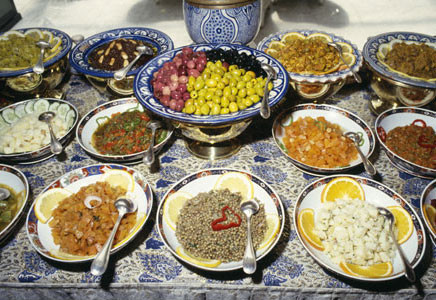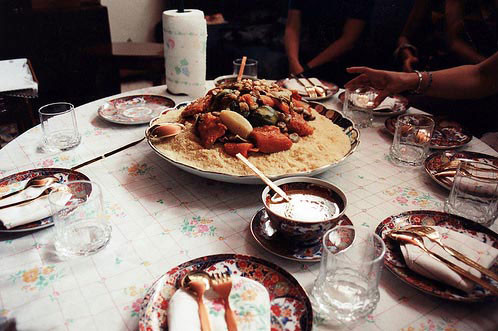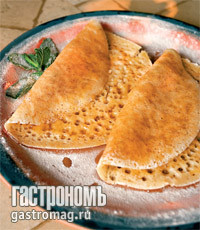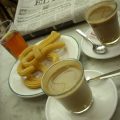A photo: Ivan Frolov The kitchen of Morocco can surprise even the most sophisticated gourmet with its culinary masterpieces: slow-fried lamb (so soft that it can be spread on bread like butter). Chicken with the flavor of olives and pickled lemons. Hummus - chickpeas wiped to creamy consistency with olive oil, herbs and lemon juice.
Eat hands
 Moroccan cuisineK Moroccan cooking meintroduced my American friend Carl, who lived in this country for many years and once decided to make friends a surprise. When we came to him for dinner, there were no instruments on the table at all. "We will eat with our hands," announced Karl. The guests did not cause stormy joy. Only the youngest daughter of the owner happily clapped her hands, anticipating a cheerful evening. Initially, each were offered bowls filled with water and rose petals. They say that at one time at a diplomatic reception such a bowl was given to one of the Soviet leaders, and he drank it in one gulp. But most likely it is an old joke. Of course, rose water is quite suitable for drinking, but Moroccans serve it so that the guest will wash his hands, because he has to eat with the help of the large, index and middle fingers of his right hand. Even if you were accustomed to fork and knife from infancy, discard traditional etiquette when you sit down at a Moroccan table. I give my word of honor, it is very pleasant to eat food with my hands. But it wasn’t enough without a spoon, because soup was the first on the table. Moroccans have a great variety of snacks, but if you are invited to a dinner party, it will begin with soup. We were given two at once - harira and chorba. The first is made from lamb with coriander and beans and traditionally marks the end of the fast of Ramadan. Chorba is a spicy chicken broth. God knows how many spices poured into him the generous hand of our host. Simultaneously with the soup, baked lamb meat and pastilla (not to be confused with our sweet marshmallow) was served to the table. Moroccan pastilla is a traditional dish for major events, for example, to meet an honored guest. It is made from the meat of pigeons, hard-boiled eggs and almonds, laid between layers of very thin dough. Sprinkle with a large amount of powdered sugar, and sometimes cinnamon. It is said that the more layers of meat and dough in the pastilla, the better relate to the guest.
Moroccan cuisineK Moroccan cooking meintroduced my American friend Carl, who lived in this country for many years and once decided to make friends a surprise. When we came to him for dinner, there were no instruments on the table at all. "We will eat with our hands," announced Karl. The guests did not cause stormy joy. Only the youngest daughter of the owner happily clapped her hands, anticipating a cheerful evening. Initially, each were offered bowls filled with water and rose petals. They say that at one time at a diplomatic reception such a bowl was given to one of the Soviet leaders, and he drank it in one gulp. But most likely it is an old joke. Of course, rose water is quite suitable for drinking, but Moroccans serve it so that the guest will wash his hands, because he has to eat with the help of the large, index and middle fingers of his right hand. Even if you were accustomed to fork and knife from infancy, discard traditional etiquette when you sit down at a Moroccan table. I give my word of honor, it is very pleasant to eat food with my hands. But it wasn’t enough without a spoon, because soup was the first on the table. Moroccans have a great variety of snacks, but if you are invited to a dinner party, it will begin with soup. We were given two at once - harira and chorba. The first is made from lamb with coriander and beans and traditionally marks the end of the fast of Ramadan. Chorba is a spicy chicken broth. God knows how many spices poured into him the generous hand of our host. Simultaneously with the soup, baked lamb meat and pastilla (not to be confused with our sweet marshmallow) was served to the table. Moroccan pastilla is a traditional dish for major events, for example, to meet an honored guest. It is made from the meat of pigeons, hard-boiled eggs and almonds, laid between layers of very thin dough. Sprinkle with a large amount of powdered sugar, and sometimes cinnamon. It is said that the more layers of meat and dough in the pastilla, the better relate to the guest.
Gold groats
Naturally, not without couscous. Indeed, in the countries of the Maghreb is one of the main foods. This cereal (and a dish of it) was invented by Berbers, who were the first to start cooking it on the basis of durum wheat semolina. Traditionally, couscous was made by women, since it is a very laborious process, and therefore not for men. Although women in the East have not yet been fully liberated, the production of couscous is now mechanized. Semolina is sprinkled with water, then from the resulting mass, grains are formed, which are then sprinkled with dry semolina or flour, and then sifted. Too small grains passing through a sieve, again sprinkled decoys, and so on to infinity.  The steaming mountain of golden cereal, in the center -colorful slices of vegetables and pieces of meat. This is the great Moroccan dish. If you breathe its scent at least once, remember it for a lifetime. Like Morocco itself, combining a multitude of cultures and traditions, couscous combines many ingredients. It must be prepared on Friday, the holy day for Muslims, they are treated to dear guests. It is served at the wake. But the wedding or the birth of a child does not cook couscous. Moroccans eat it with their hands, deftly making balls of cereal and mashed vegetables. So, they say, and tastier, and there is no risk of getting burned. Traditionally, especially in the villages, they are washed down with kefir. They prepare couscous in a special pan (Borma), in French, le couscoussier, so it is easier to call it couscous. Kusmusnitsa consists of two detachable parts: a large tall pan and a colander tightly inserted into it. Couscous is steamed and served with stewed meat and / or vegetables. Meat is always extinguished in large chunks and then divided into portions. A brilliant invention is half-cooked couscous, which you just need to fill with hot water. The classic option is to season the couscous with lemon juice and garnish with fresh mint leaves.
The steaming mountain of golden cereal, in the center -colorful slices of vegetables and pieces of meat. This is the great Moroccan dish. If you breathe its scent at least once, remember it for a lifetime. Like Morocco itself, combining a multitude of cultures and traditions, couscous combines many ingredients. It must be prepared on Friday, the holy day for Muslims, they are treated to dear guests. It is served at the wake. But the wedding or the birth of a child does not cook couscous. Moroccans eat it with their hands, deftly making balls of cereal and mashed vegetables. So, they say, and tastier, and there is no risk of getting burned. Traditionally, especially in the villages, they are washed down with kefir. They prepare couscous in a special pan (Borma), in French, le couscoussier, so it is easier to call it couscous. Kusmusnitsa consists of two detachable parts: a large tall pan and a colander tightly inserted into it. Couscous is steamed and served with stewed meat and / or vegetables. Meat is always extinguished in large chunks and then divided into portions. A brilliant invention is half-cooked couscous, which you just need to fill with hot water. The classic option is to season the couscous with lemon juice and garnish with fresh mint leaves.
When I have time
Moroccan cooking requiredA lot of time is their main disadvantage. But, as they say, the hunt is more than bondage. Free yourself a day, call guests in the evening, go to the market and to the supermarket - and for the cause.  The main tool of Moroccan cuisine istazhin - special clay container with a lid. Cooked in the tajine food has a unique taste. Therefore, dishes are often called by the name of this pot, for example tajin with fish or tajin with lamb. Traditionally, the tagine is cooked on coals, but at home you can do with a gas stove. It is necessary to cook for a long time, on a small fire, placing a diffuser under the tagine - a metal plate with holes, so that the food does not stick. If you do not have couscous at home and you haven’t got your own tagine yet, I’m ready to share the recipe of another delicious Moroccan dish that has delighted my friends more than once. When ready, do not say it, let them try to guess themselves. Be patient - and for the cause. First we need saffron. Moroccans add this spice to almost all dishes. In order for the saffron to give the dish its aroma and color, it must be preheated, for example, in a dry frying pan (super small fire, do not burn it!), Then let it rest for a few minutes. But I advise you to just put the stamens of saffron on the lid of the cauldron, which you can easily replace the exotic tagine. Fill a generous pinch of warm saffron with a small amount of hot water, and let it wait in the wings. In the meantime, take a pound of white fish fillet and cut it into pieces. In principle, you can use any fish, as long as it is fresh and boneless. You will also need a couple of green onion feathers, a bunch of parsley and cilantro, an egg and dry bread crumbs. Pour it all into a blender, add water from under the saffron and mix well.
The main tool of Moroccan cuisine istazhin - special clay container with a lid. Cooked in the tajine food has a unique taste. Therefore, dishes are often called by the name of this pot, for example tajin with fish or tajin with lamb. Traditionally, the tagine is cooked on coals, but at home you can do with a gas stove. It is necessary to cook for a long time, on a small fire, placing a diffuser under the tagine - a metal plate with holes, so that the food does not stick. If you do not have couscous at home and you haven’t got your own tagine yet, I’m ready to share the recipe of another delicious Moroccan dish that has delighted my friends more than once. When ready, do not say it, let them try to guess themselves. Be patient - and for the cause. First we need saffron. Moroccans add this spice to almost all dishes. In order for the saffron to give the dish its aroma and color, it must be preheated, for example, in a dry frying pan (super small fire, do not burn it!), Then let it rest for a few minutes. But I advise you to just put the stamens of saffron on the lid of the cauldron, which you can easily replace the exotic tagine. Fill a generous pinch of warm saffron with a small amount of hot water, and let it wait in the wings. In the meantime, take a pound of white fish fillet and cut it into pieces. In principle, you can use any fish, as long as it is fresh and boneless. You will also need a couple of green onion feathers, a bunch of parsley and cilantro, an egg and dry bread crumbs. Pour it all into a blender, add water from under the saffron and mix well.  Get ground minced. Form balls of any size from it. I am guided by the saying that a large piece of mouth is happy, and therefore I make large ones. Put the balls in the fridge and have a sauce. First, we need good tomatoes without a peel (it is very easy to separate the skin, if you dip a tomato impaled on a fork into boiling water for a few seconds). Squeeze the seeds out of the tomatoes and cut into large pieces. In olive oil, fry the onion in the cauldron or utiatnice until golden brown, then add the whole cloves of one garlic clove. Now is the time for spices. Feel free to throw a teaspoon of sweet paprika into the frying pan on the onion and garlic, on the tip of a knife cayenne or any other hot pepper, cumin, ground coriander. Then after a minute, put the tomatoes, sugar, salt, sprinkle it all with black pepper and pour in a cup of water. Let stew and turn into sweet and sour sauce. If you want, add some lemon juice - it will be more recently; add more sugar - it will be sweeter. Now get the balls out of the fridge and shift them to the cauldron. Let it stew again. The main thing is not to burn. Serve these balls (or meatballs - call it what you want) to the table with fried potatoes, sprinkle them plentifully with greens. Radish salad with lemon juice will be a worthy addition to this dish. Moroccans are Muslims, and although they produce wine, they do not drink. I would recommend a good bottle of Chablis. So we will connect the incompatible - East and West.
Get ground minced. Form balls of any size from it. I am guided by the saying that a large piece of mouth is happy, and therefore I make large ones. Put the balls in the fridge and have a sauce. First, we need good tomatoes without a peel (it is very easy to separate the skin, if you dip a tomato impaled on a fork into boiling water for a few seconds). Squeeze the seeds out of the tomatoes and cut into large pieces. In olive oil, fry the onion in the cauldron or utiatnice until golden brown, then add the whole cloves of one garlic clove. Now is the time for spices. Feel free to throw a teaspoon of sweet paprika into the frying pan on the onion and garlic, on the tip of a knife cayenne or any other hot pepper, cumin, ground coriander. Then after a minute, put the tomatoes, sugar, salt, sprinkle it all with black pepper and pour in a cup of water. Let stew and turn into sweet and sour sauce. If you want, add some lemon juice - it will be more recently; add more sugar - it will be sweeter. Now get the balls out of the fridge and shift them to the cauldron. Let it stew again. The main thing is not to burn. Serve these balls (or meatballs - call it what you want) to the table with fried potatoes, sprinkle them plentifully with greens. Radish salad with lemon juice will be a worthy addition to this dish. Moroccans are Muslims, and although they produce wine, they do not drink. I would recommend a good bottle of Chablis. So we will connect the incompatible - East and West.
Tea is life
So says one of my friends - a great connoisseur andtea lover. For dessert (seasonal fruits and sweet pies with fillings, including honey, nuts, cinnamon, sesame and fennel seeds), green tea is prepared with fresh mint and lots of sugar. This is an excellent tool to improve digestion after a hearty meal. There is also a special Moroccan hit - orange tea. Everyone knows that Morocco is a country of oranges. From their flowers turns out unusually fragrant water. Her and add to tea. In Russia, I have not seen it on sale, so if you want to try, go to Morocco. You will not regret.
Chicken Pastilla

- 4 servings
What do you need:
- 4 chicken legs
- 4 large onions
- 100 g of butter
- 1 tbsp. l vegetable oil
- 1/2 liter chicken broth
- 6 eggs plus 1 egg for lubrication
- 100 g minced almonds
- 8 sheets of filo dough
- on a small bunch of parsley and cilantro
- 2 cinnamon sticks
- 1 tsp. turmeric
- 1 tsp. ground ginger
- 5 tsp. powdered sugar
- 3 tsp. ground cinnamon
- salt and pepper to taste
What to do:Fry whole chicken legs in vegetable and butter together with chopped onions, for 3 minutes. from each side. Add all the spices and finely chopped herbs, pour the broth and, 25-30 min. Remove the chicken, cool, separate the meat from the bones and cut into cubes. Pour lightly beaten eggs into the remaining broth and cook over low heat, stirring continuously, for about 30 minutes, until smooth. Throw the resulting sauce on a sieve to glass excess liquid, cool. In the center of the first sheet of filo dough, put the chicken fillet, egg sauce, sprinkle with cinnamon and sugar, put the almonds. Wrap the edges of the dough, brush with an egg, cover with a second sheet, turn over, wrap the edges. Let the pastille dry for 5-10 minutes, grease with vegetable oil, bake in the oven at 180 ° C, 10 minutes. Sprinkle generously with powdered sugar and cinnamon before serving.
Pancakes bagrir

- 4 servings
What do you need:
- 250 g of semolina
- 250 g flour
- 1 egg
- on a pinch of salt and sugar
- 400 ml of milk
- 1 bag (7 g) dry yeast
- powdered sugar and mint for decoration
For sauce:
- 4 tbsp. l honey
- 4 tsp. butter
What to do: Mix all ingredients for pancakes with a mixer, add 1 cup of water. Put the dough in a warm place for 30 minutes. Bake pancakes in a skillet with a diameter of 20 cm. For the sauce, melt butter and honey over low heat. Put two pancakes on plates, smear with sauce, sprinkle with powdered sugar, decorate with fresh mint.









